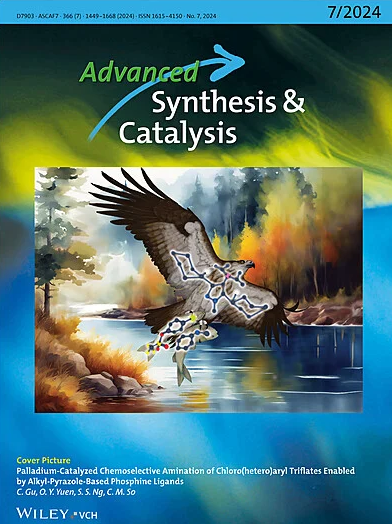Biomimetic Orthogonal Removal of Arylacyl Protecting Groups from the C-Terminus of Substituted Amino Acids and Oligopeptides via Flavin N(5)-iminium Covalent Adducts
IF 4.4
2区 化学
Q2 CHEMISTRY, APPLIED
引用次数: 0
Abstract
Flavin co-factors and other flavin derivatives are traditionally associated with one- or two-electron redox reactions. Flavins also form covalent intermediates with a variety of substrates. While extensive attention has focused on reactions at the C(4a) position of the flavin ring, recent interest has shifted toward the dynamic potential of the N(5) atom. In our study, we demonstrate the formation of artificial flavin N(5)-iminium covalent adducts via nucleophilic attack by enolates derived from arylacyl esters at the flavin N(5) position. This interaction mimics the biosynthesis of ether phospholipids catalysed by alkyl-dihydroxyacetone phosphate synthase via an N(5)-FAD iminium adduct formation and fatty acid release. Accordingly, we developed a method for the selective removal of phenacyl and 2-naphthylacetyl protecting groups from the C-terminus of α-amino acids and di- and tripeptides using biomimetic flavin organocatalysis. Although many approaches are currently available for protection of C-terminus of peptides, their removal often requires harsh conditions, which cause racemization and the loss of optical purity, together with other side reactions. Our method is versatile, mild, orthogonal to most functional and protecting groups and maintains optical purity of α-amino acids. From general point of view, the method signifies the groundbreaking application of the non-canonical reactivity of flavins in organic synthesis.求助全文
约1分钟内获得全文
求助全文
来源期刊

Advanced Synthesis & Catalysis
化学-应用化学
CiteScore
9.40
自引率
7.40%
发文量
447
审稿时长
1.8 months
期刊介绍:
Advanced Synthesis & Catalysis (ASC) is the leading primary journal in organic, organometallic, and applied chemistry.
The high impact of ASC can be attributed to the unique focus of the journal, which publishes exciting new results from academic and industrial labs on efficient, practical, and environmentally friendly organic synthesis. While homogeneous, heterogeneous, organic, and enzyme catalysis are key technologies to achieve green synthesis, significant contributions to the same goal by synthesis design, reaction techniques, flow chemistry, and continuous processing, multiphase catalysis, green solvents, catalyst immobilization, and recycling, separation science, and process development are also featured in ASC. The Aims and Scope can be found in the Notice to Authors or on the first page of the table of contents in every issue.
 求助内容:
求助内容: 应助结果提醒方式:
应助结果提醒方式:


